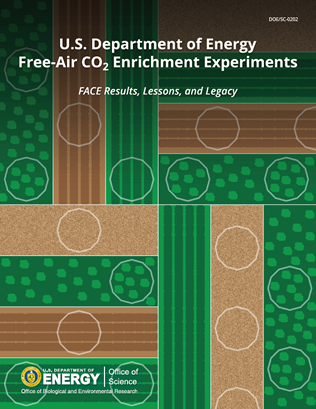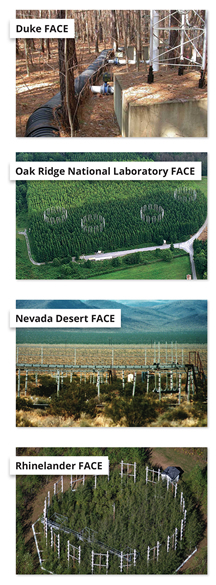Free-Air CO2 Enrichment Experiments: Results, Lessons, and Legacy
 Growing concern in the 1970s about potential long-range consequences of carbon dioxide (CO2) emissions from the combustion of fossil fuels prompted the U.S. Department of Energy (DOE) to begin developing a CO2 research program. The goal was to obtain the scientific information needed to reduce uncertainty and develop a knowledgebase for decision-making. At its start in 1980, this program had three components: the global carbon cycle, climate effects, and vegetation effects. The vegetation effects component recognized that increased atmospheric CO2 could be a potential benefit to vegetation and crops because CO2 is an essential resource for plant growth. In addition to increasing crop yield, program developers and researchers recognized that this fertilizer effect could also result in greater storage of fossil fuel CO2 by forests.
Growing concern in the 1970s about potential long-range consequences of carbon dioxide (CO2) emissions from the combustion of fossil fuels prompted the U.S. Department of Energy (DOE) to begin developing a CO2 research program. The goal was to obtain the scientific information needed to reduce uncertainty and develop a knowledgebase for decision-making. At its start in 1980, this program had three components: the global carbon cycle, climate effects, and vegetation effects. The vegetation effects component recognized that increased atmospheric CO2 could be a potential benefit to vegetation and crops because CO2 is an essential resource for plant growth. In addition to increasing crop yield, program developers and researchers recognized that this fertilizer effect could also result in greater storage of fossil fuel CO2 by forests.
Initial experiments were small in scale and scope and focused on the photosynthesis, physiology, and water use of crop plants, but the focus shifted toward responses of plants in natural systems, as needed for connections to the global carbon cycle. Program research investigated CO2 interactions with other environmental variables, emphasizing field research whenever possible and recognizing that exposure to elevated CO2 concentrations under realistic field conditions should lead to better predictions of plant response.
Whole-ecosystem field experiments were instituted in low-stature ecosystems, but experiments to address forest responses necessarily relied on tree seedlings or saplings in open-top chambers (OTCs) and not within intact forest ecosystems. The need for larger-scale, longer-duration experiments in each of the world’s six major biomes (tundra, boreal forest, temperate forest, tropical forest, grassland, and desert) became clear, and for these experiments, free-air CO2 exposure facilities were necessary.
FACE Experiments
The Free-Air CO2 Enrichment (FACE) technology was first developed by Brookhaven National Laboratory (BNL) for use in an agricultural setting. Elevated CO2 experiments, combined with manipulations of water and nitrogen supply, were conducted from 1989 to 1999 in Maricopa, Ariz., with cotton, wheat, and sorghum. Cotton was shown to be highly responsive to CO2 enrichment, but the C4 sorghum was not. Interactions with water and nitrogen varied across species. The BNL FACE system was scaled up for use with tall vegetation, and a prototype forest FACE system was tested in the Duke University Forest in 1994 and 1995, leading to a fully replicated FACE experiment in the loblolly pine forest in 1996. Other FACE experiments with forest stands and native vegetation began in 1997 at Oak Ridge National Laboratory (ORNL) in Tennessee (ORNL FACE in a sweetgum plantation), at the Nevada National Security Site (Nevada Desert FACE), and on U.S. Forest Service land in Wisconsin (Rhinelander FACE with trembling aspen mixed with sugar maple and paper birch). Over 10 to 12 years, these experiments exposed the vegetation in replicated, 25-m to 30-m diameter plots to ambient or elevated CO2 (about 550 to 565 parts per million). In the Rhinelander FACE experiment, the CO2 treatments were combined with ambient or elevated ozone, and the Duke FACE experiment added a nitrogen fertilization treatment toward the end.
Key Results from FACE Experiments
- Increased net primary production (NPP) in elevated CO2 was sustained throughout the Duke FACE experiment and resulted in greater woody biomass accumulation. The increased production was supported by an increased flux of carbon below ground, which stimulated tree uptake of nitrogen bound in soil organic matter and created a positive feedback through increased canopy nitrogen and greater photosynthesis. Slow adjustments in canopy structure meant that short-term leaf-scale responses of stomatal conductance to elevated CO2 were not translated directly to canopy water-use responses, emphasizing the importance of long-term experiments whose durations are sufficient for slow responses to manifest.
- An initial stimulation of aboveground growth by elevated CO2 in the ORNL FACE experiment was quickly dissipated, but NPP was enhanced with the additional productivity accounted for by enhanced production of fine roots, especially deeper in the soil, which sustained increased nitrogen uptake needed to support increased NPP. However, nitrogen availability steadily declined, leading to a loss of photosynthetic enhancement and the NPP response. This decline occurred faster in elevated CO2, supporting the premise of progressive nitrogen limitation.
- The Nevada Desert FACE Facility was the only DOE FACE experiment that examined the impact of elevated atmospheric CO2 on an arid ecosystem and took place in an undisturbed, natural ecosystem. Responses of the desert vegetation to elevated CO2 were highly dependent on precipitation patterns. Photosynthesis was stimulated by elevated CO2, increasing leaf-level carbon gain, with larger effects in wet years than during extended drought years. This response supported increased aboveground growth only in the wet years. After 10 years, there was no detectable effect of elevated CO2 on aboveground biomass or community structure of the perennial plant community.
- The Rhinelander FACE experiment was initiated in a seedling stand and, therefore, was an expanding system through most or all of the experimental duration. Many of the responses reported early in the experiment were not sustained, emphasizing the importance of projecting the responses of seedlings and young trees to mature forests, as well as the value in maintaining experiments for as long as is feasible. Ozone was found to counteract some of the effects of elevated CO2, suggesting that projections of CO2 responses will be overstated if the co-occurrence of ozone is not considered. However, the negative effects of ozone on growth dissipated by the end of the experiment.
FACE Report
This report summarizes the objectives and main results of DOE-sponsored experiments employing such facilities, along with the outcomes from research on ecosystem responses using field chambers. Additionally, this report highlights the many successes of DOE CO2 enrichment studies and considers the lessons learned that can be used to guide future initiatives.
- Print Publication: June 2020
- Report Download: Print-quality PDF
- Report Download: Fast-download PDF
- FACE_Timeline: Stand-alone 11″ x 17″ PDF
- Suggested Citation: U.S. DOE. 2020. U.S. Department of Energy Free-Air CO2 Enrichment Experiments: FACE Results, Lessons, and Legacy, DOE/SC–0202. U.S. Department of Energy Office of Science. DOI:10.2172/1615612. [ess.science.energy.gov/wp-content/uploads/2020/12/facereport2020.pdf]
FACE Data Downloads
- FACE Data on ESS-DIVE
- FACE Model-Data Synthesis (FACE-MDS)
Image Credits
- Duke FACE. [Courtesy Jeffrey S. Pippen, Duke University.]
- ORNL FACE. [Reprinted by permission from Springer Nature from Medlyn, B. E., et al. 2015. “Using Ecosystem Experiments to Improve Vegetation Models,” Nature Climate Change 5, 528–34. Copyright 2015.]
- Nevada Desert FACE. [Courtesy DOE]
- Rhinelander FACE. [Reprinted under a Creative Commons License (CC-BYNC- ND 4.0) from McSweeney, R. 2015. “Leaf-Eating Insects May Limit How Much Carbon Forests Absorb, Study Says,” Carbon Brief. Copyright 2015.]
